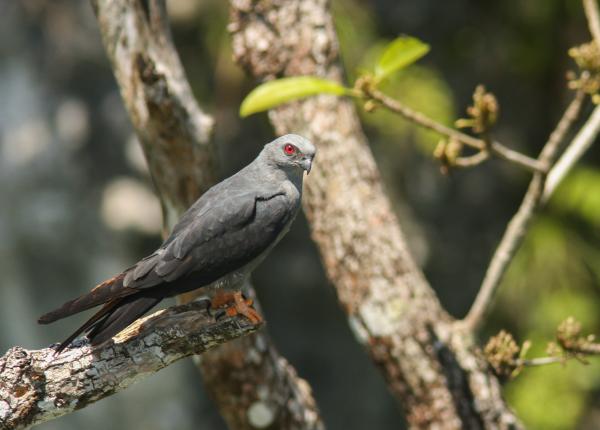Did You Know?
- Despite its wide range throughout South America, the Plumbeous Kite is not found in Uruguay or Chile.
- Plumbeous Kites are likely monogamous, meaning they mate for life.
- Similar to the Double-toothed Kite, the Plumbeous Kite has been known to follow troops of marmosets (a type of monkey) in the hopes that the monkeys will flush out potential prey - such as cicadas and other large insects.
- Though Plumbeous Kites usually only lay one egg per clutch, individuals in the northern part of their range will often lay 2 eggs!
How The Peregrine Fund is Helping
From 1988 to 1996, The Peregrine Fund was dedicated to studying Neotropical birds of prey in the Peten region of Guatemala in an ambitious undertaking called the Maya Project. All the information gathered on diet, nesting, threats and behavior helped contribute to the scientific world's knowledge of many of these species.This is important because the more we know about a species, the better we are able to help conserve it. The Peregrine Fund published the results of the Maya Project in a book called "Neotropical Birds of Prey, Biology and Ecology of a Forest Raptor Community."
Additionally, our efforts in scientific research, habitat conservation, education, and community development help conserve raptors on a global scale. We also supply literature to researchers from our avian research library, which helps scientists around the world gather and share important information on raptor conservation. We also support the Neotropical Raptor Network - a group that helps conserve birds of prey by improving communication and collaboration among raptor enthusiasts throughout the region!
Where They Live
The Plumbeous Kite is a neotropical bird of prey. It is found from southeastern Mexico throughout Central America and most of South America. This beautiful kite makes its home in lowland and middle elevation forest patches, riparian forest, open pastures and savannas dotted with trees. It has also been seen soaring, hunting, and perching in logged woodland, recently plowed or burning fields, and mangroves. It rarely spends time in dense, tropical forests.
What They Do
The word "plumbeous" means the "color of lead." This is the perfect name for this kite. It is a lovely slate-gray almost all over its body. It has yellow legs and deep red eyes. It seems almost impossible, but in flight, this beautiful raptor becomes even more lovely. The white barring on its tail becomes more visible as do the rufous patches on their primary feathers. This species spends a lot of time soaring, which it does quite gracefully. If you are ever in Plumbeous Kite territory, be sure to look to the sky. You might spot it soaring alone, in pairs, or in small groups of other Plumbeous Kites, or sometimes with flocks of other raptor species. Of course, don't forget to scan any high, exposed branches as well. This is where these kites often like to perch.
The Plumbeous Kite is a diurnal bird of prey, meaning it soars, hunts, breeds, and generally goes about its business during daylight hours, and rests at night. This species isn't particularly vocal, though during breeding season it will call more - sometimes during changing shifts when incubating eggs, or to warn off predators venturing into their territory.
Why they need our help
The Plumbeous Kite is widespread and fairly common throughout its range. Because of this, it has been categorized as a species of Least Concern by BirdLife International. Additionally, because this kite can be found along forest edges and has adapted to taking advantage of burned and plowed fields to find prey, it might be able to do better than many other raptors in human-altered environments.
What They Eat
The Plumbeous Kite has a long list of animals on its menu. While it mainly feeds on insects such as ants, termites, cicadas, dragonflies, butterflies, lacewings, grasshoppers, crickets, locusts, and more, it also occasionally feasts upon bats, birds, snakes, lizards, and frogs. Researchers have observed many Plumbeous Kites gathering together to feed when winged termites emerge from underground in large groups.
In order to catch a wide variety of prey, this kite employs several different hunting techniques. It uses its feet to catch its prey which it might pluck from the vegetation. It also catches insects on the wing and eats them while still in flight. It sometimes snatches lizards from the ground, often in recently burned areas.
Nest, Eggs, and Young
The female and male Plumbeous Kite work together to build their nests. Gathering twigs and sticks, they fashion a small platform nest in which to lay their eggs. When the nest has been constructed, they will line it with leaves or other soft materials, such as Spanish Moss. Most often, these birds choose to build their nest at mid to high levels in the crotch of a tree. The pair might re-use this nest year after year, adding new sticks and twigs, or making repairs to it as needed.
The female will lay a clutch of 1-2 eggs, but usually just one. Researchers have described Plumbeous Kite eggs as being plain white or bluish-white.
Just as both parents help build the nest, both parents continue working together to help incubate their eggs. They take turns sitting on their eggs to keep them warm and safe so that the embryos inside can develop into healthy nestlings, which take about 31-32 days. After the nestlings hatch, their parents work hard to bring them all the food they need to grow. After all the young will develop quickly and in a little over a month they will be ready to fly from the nest for the first time.
While Plumbeous Kites have been described as being fairly "mellow" birds, all this changes when they sense that their nest, eggs, or young are in danger. Then they become very aggressive, chasing off potential predators with loud cries and swift stoops. And for good reason. Several species will prey on these kites' eggs and young, including toucans.
Plumbeous Kite and The World Center for Birds of Prey
The World Center for Birds of Prey offers fun ways to learn about birds of prey. Interactive activities, tours, interesting videos and a children's room with activities from coloring sheets to quizzes to costumes. Owls are included among the ambassador birds at the visitor center, providing visitors with a wonderful opportunity to see owls up close and learn about the wonderful and interesting adaptations they have in order to survive in their respective habitats. There is also a touch table with owl feathers and other natural objects available for exploration.
References:
Bodrati, A. and Cockle, K.L., 2017. Nest predation and interspecific nesting associations involving Plumbeous Kite (Ictinia plumbea) and Becards (Pachyramphus spp.).
Global Raptor Information Network. 2021. Species account: Plumbeous Kite Ictinia plumbea. Downloaded from http://www.globalraptors.org on 13 Aug. 2021
Seavy, N.E., Schulze, M.D., Whitacre, D.F. and Vásquez, M.A., 1997. Diet and hunting behavior of the Plumbeous Kite. The Wilson Bulletin, pp.526-532.
Yu, H. (2020). Plumbeous Kite (Ictinia plumbea), version 1.0. In Birds of the World (T. S. Schulenberg, Editor). Cornell Lab of Ornithology, Ithaca, NY, USA. https://doi.org/10.2173/bow.plukit1.01









